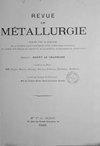热成形铸钢的孔隙率
Revue De Metallurgie-cahiers D Informations Techniques
Pub Date : 2020-01-01
DOI:10.37904/metal.2020.3480
引用次数: 0
摘要
为了减少锻钢工艺的工序数。因此,刀具磨损和工艺成本,定制预制几何形状可以通过铸造生产。仅通过一次后续成形操作,就可以改善铸件的微观组织,消除可能的缺陷并达到所需的机械性能。为了评估铸件微观组织的性能以及在温/热成形过程中可能存在的铸造缺陷的封闭,采用砂型铸造生产了圆柱形钢坯(C45/1.0503),然后在液压机中进行了镦粗。当锻造温度为600℃和1200℃时,整体塑性应变φ在0.3 ~ 0.7之间变化,以检测可能的温度影响。以相同条件下形成的常规轧制棒材为参照。成形后,试样回火,并通过拉伸试验(ISO 6892-1)和缺口冲击试验(类似于ISO 148-1)确定力学性能。显微组织通过金相分析检测,缺陷利用光学广域三维测量系统和数字图像处理进行表征。可以观察到,铸锻试样的极限抗拉强度取决于成形温度,在600℃和1200℃的成形温度下,铸锻试样的极限抗拉强度分别比对照材料低15%和5%。铸锻件和参考试样的冲击能均与塑性应变密切相关。参考试样的力学性能值高于铸锻试样。这些结果使人们对钢的铸锻过程有了更深入的了解,并将有助于更复杂钢件的铸锻设计。本文章由计算机程序翻译,如有差异,请以英文原文为准。
Porosity in Hot Formed Cast Steel
In order to reduce the number of process steps of steel forging processes. and thus also tool wear and process costs, tailored preform geometries can be produced by casting. By only one subsequent forming operation it is possible to improve the casting microstructure, eliminate possible defects and achieve the required mechanical properties. To evaluate the properties of the cast microstructure and the closure of possible casting defects during warm/hot forming, cylindrical steel billets (C45/1.0503) were produced by sand casting and then upset in a hydraulic press. Global plastic strain φ was varied between 0.3 and 0.7 while forging temperatures of 600 °C and 1200 °C were applied to detect possible temperature effects. Conventional rolled bar material formed under the same conditions was used as a reference. After forming, the specimens were tempered and the mechanical properties were determined by tensile tests (ISO 6892-1) and notch impact tests (similar to ISO 148-1). The microstructures were examined by metallographic analysis while defects were characterised using an optical wide-area 3D measurement system and digital image processing. It could be observed that the ultimate tensile strength of the cast-forged specimens depends on the forming temperature and is about 15 % lower in comparison to the reference material at a forming temperature of 600 °C and 5 % lower at 1200 °C, respectively. The impact energies show a strong dependence on plastic strain for both, the castforged and reference specimens. The values of the mechanical properties of the reference specimens were higher than those of the cast-forged specimens. These results allow a deeper understanding of the cast-forging of steel and will contribute to the cast-forging design of more complex steel parts.
求助全文
通过发布文献求助,成功后即可免费获取论文全文。
去求助
来源期刊
自引率
0.00%
发文量
0
审稿时长
24 months

 求助内容:
求助内容: 应助结果提醒方式:
应助结果提醒方式:


